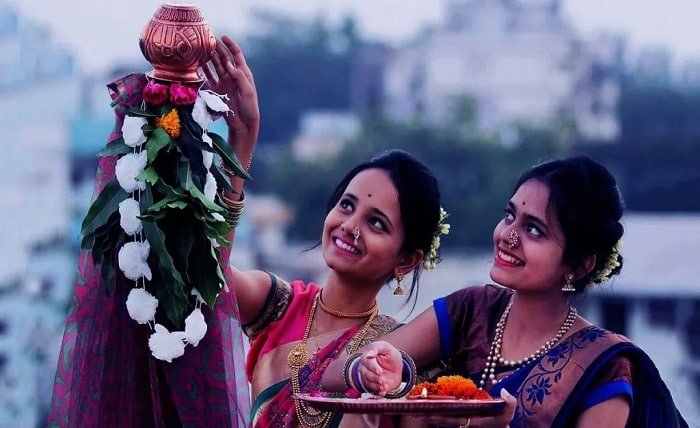Gudi Padwa: Significance, Traditions, and Festive Celebrations of the Maharashtrian New Year

Gudi Padwa: Introduction to the Festive New Year
Gudi Padwa is one of the most significant festivals celebrated in the Indian state of Maharashtra, marking the beginning of the Hindu lunar calendar. Gudi Padwa is not just a New Year celebration but a symbol of prosperity, hope, and cultural heritage. On Gudi Padwa, people adorn their homes with beautiful rangolis, hoist a gudi (a decorated flag-like structure), and welcome the new beginnings with prayers and joy. The term “Padwa” is derived from the Sanskrit word “Pratipada,” which means the first day of a lunar fortnight, and thus Gudi Padwa falls on the first day of Chaitra month, heralding a new season of abundance and growth.
Gudi Padwa: The Historical and Mythological Significance
The history of Gudi Padwa traces back to ancient times, with various legends associated with its origin. One of the most popular beliefs is that Gudi Padwa marks the day when Lord Brahma created the universe. This makes Gudi Padwa spiritually significant, especially among devotees who begin the year with prayers and meditations. Another legend states that Gudi Padwa commemorates the victory of the legendary King Shalivahana over enemies, marking the beginning of the Shalivahana calendar. People raise the gudi on this day to symbolize victory, much like a flag is hoisted after a triumphant conquest. Hence, Gudi Padwa is both a mythological and historical celebration of new beginnings.
Gudi Padwa: Rituals, Customs, and Symbolism of the Gudi
Central to the Gudi Padwa celebration is the ‘gudi’ itself, which is a bamboo stick adorned with a bright silk cloth, neem leaves, sugar crystals, a garland of flowers, and an inverted copper or silver vessel on top. The gudi is placed outside the house, usually on the right side of the main entrance, and is believed to ward off evil, invite prosperity, and symbolize victory. On Gudi Padwa, families wake up early, take a ritual bath, clean their homes, and perform a special pooja to honor the gudi. The practice of hoisting the gudi represents the welcoming of good luck and positive energy, which is why Gudi Padwa is known as an auspicious start to the new year.
Gudi Padwa: Cultural Celebrations and Regional Variations
While Gudi Padwa is primarily a Maharashtrian festival, it is also celebrated under different names in various parts of India. For instance, in Andhra Pradesh and Telangana, the festival is known as Ugadi, and in Karnataka, it’s celebrated as Yugadi. Despite regional differences, the essence of Gudi Padwa remains the same—celebrating the new year with prayers, festivities, and traditional foods. Gudi Padwa is also marked by processions featuring traditional music, dance forms like Lezim, and community gatherings that highlight the rich Marathi culture. Women and men dress in traditional attire, and children enjoy participating in various cultural programs organized to honor the spirit of Gudi Padwa.
Gudi Padwa: Traditional Foods and Festive Delicacies
Gudi Padwa is incomplete without the delightful array of Maharashtrian dishes that are specially prepared to mark the occasion. One of the must-have items on Gudi Padwa is “Puran Poli,” a sweet flatbread made of jaggery and lentils, often served with ghee. Another significant dish is “Shrikhand,” a sweet yogurt-based dessert that adds to the festive mood. On Gudi Padwa, families also consume a special mixture of neem leaves and jaggery, symbolizing the balance of bitter and sweet experiences in life. This combination signifies that the coming year may have both joys and challenges, and Gudi Padwa teaches us to embrace both with grace.
Gudi Padwa: Fashion, Decorations, and Community Spirit
The beauty of Gudi Padwa is also reflected in the vibrant decorations and traditional attire worn during the celebration. On Gudi Padwa, women wear Nauvari sarees, often paired with traditional jewelry like nath (nose ring), chandrakor bindi, and green glass bangles. Men wear kurta-pajamas with a saffron turban called ‘pheta’. Homes are decorated with colorful rangoli patterns, torans (garlands) of mango and neem leaves, and fresh flowers to create a festive atmosphere. Gudi Padwa is also a time when people come together as a community, participate in temple visits, and spread positivity and unity, reflecting the core values of this sacred festival.
Gudi Padwa: Astrological Importance and Spiritual Practices
Gudi Padwa holds great significance in Vedic astrology as well, being the first day of the Chaitra month and also marking the beginning of the spring season. According to Hindu tradition, Gudi Padwa is an ideal day to initiate new ventures, investments, and projects, as it is considered astrologically favorable. Many people consult astrologers on Gudi Padwa to determine their horoscopes and plan their year accordingly. The spiritual aspect of Gudi Padwa is highlighted through temple visits, donations, chanting mantras, and meditating on personal growth. Gudi Padwa encourages introspection, self-discipline, and the cultivation of gratitude as a way to start the year with positivity.
Gudi Padwa: Modern-Day Celebrations and Global Recognition
In recent years, Gudi Padwa has gained recognition beyond Maharashtra and India, thanks to the global diaspora of the Marathi community. Today, Gudi Padwa is celebrated in countries like the USA, UK, Canada, UAE, and Australia, where communities organize cultural programs, online festivities, and virtual poojas. Social media platforms are flooded with Gudi Padwa wishes, images of gudis, and festive reels that reflect how tradition blends beautifully with modern expressions. In cities like Mumbai and Pune, Gudi Padwa processions feature dhol-tasha performances, showcasing the grandeur and excitement of the festival. With evolving times, Gudi Padwa continues to retain its cultural core while embracing new-age celebrations.
Conclusion
Gudi Padwa is more than a date on the calendar; it is a celebration of victory, tradition, unity, and new beginnings. As a festival that blends mythology, spirituality, culture, and community spirit, Gudi Padwa stands out as a meaningful occasion that connects the past with the present. From hoisting the symbolic gudi to indulging in traditional sweets and performing rituals, every aspect of Gudi Padwa reminds us of renewal and resilience. No matter where or how it is celebrated, Gudi Padwa continues to inspire people to begin the new year with gratitude, hope, and festive cheer.
FAQs
1. What is the significance of the gudi in Gudi Padwa?
The gudi symbolizes victory, prosperity, and warding off evil. It is hoisted on Gudi Padwa to welcome good luck and positive energy.
2. When is Gudi Padwa celebrated each year?
Gudi Padwa is celebrated on the first day of the Chaitra month in the Hindu lunar calendar, which usually falls in March or April.
3. What are some traditional dishes made during Gudi Padwa?
Puran Poli, Shrikhand, and the bitter-sweet neem-jaggery mixture are key dishes enjoyed on Gudi Padwa.
4. How is Gudi Padwa different from Ugadi or Yugadi?
While Gudi Padwa is specific to Maharashtra, Ugadi/Yugadi is celebrated in Andhra Pradesh, Telangana, and Karnataka with similar New Year significance.
5. Why is neem consumed on Gudi Padwa?
Neem is consumed with jaggery on Gudi Padwa to symbolize the balance of life’s bitter and sweet moments and to promote health.





